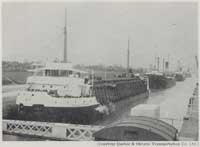Paper Carriers
The production of paper is one of Canada's major industries. Large volumes of cargo associated with this industry are moved through the canals annually and specialized types of ships have been developed to handle them.
Pulpwood Carriers
Pulpwood, the primary material of paper making is a major product of the eastern parts of the Province of Quebec and although a large proportion of this is processed in that province about half a million tons are shipped through the canals annually for processing in the Ontario and U.S. mills:
 |
| Fig. 30 Pulpwood Carrier Irvingwood, Built in 1952 |
Almost all canallers are used at various times for the carriage of pulpwood but some ships have been specially designed for this cargo, such as the Irvingwood, Fig. 30. Owing to its high stowage factor a large proportion of the cargo must necessarily be carried on deck. As pulpwood is normally cut into standard lengths of 4 ft the hatch sides are arranged 4 ft 6 in. to 5 ft inside the deck edge so that the outside tier of logs can be stacked on the deck clear of the hatch. To facilitate deck cargo stowage the upper deck guard wire stanchions are arranged to hinge down onto the deck and portable wood cages are fitted over the deck machinery.
Wood Pulp Carriers
 |
| Fig. 31 Processed Wood-pulp Carrier D. C. Everest, Built in 1952 |
While the quantity of processed wood pulp being carried through the canals is relatively small and is usually carried in ordinary bulk canallers, it is interesting to note that a canal-sized vessel, the D. C. Everest, Fig. 31, was designed especially for this cargo in 1902.
Newsprint Carriers
The finished paper is made up in large rolls of various standard sizes which, although relatively dense themselves, stow at a fairly high cubic rate per ton. A special type of vessel is therefore required for paper transport having a trunk about 13 ft high above the upper deck with a complete trunk deck and weathertight hatch covers. The hull depth, trunk width and height are arranged as multiples of the standard roll dimensions so that a minimum of dunnage is required.
 |
| Fig. 32 Newsprint Carrier Chicago Tribune, Built in 1930 |
The Chicago Tribune ex Thorold, Fig. 32, is an example of this type of construction. The mooring-winch difficulty is solved in this ship by carrying the trunk deck out to the ship's side to provide platforms for the fairleads.
Previous
Next
Return to Home Port
This paper was presented at a meeting of the Society of Naval Architects and Marine Engineers and is reproduced with permission.
|

